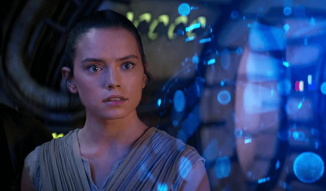
The story of the Cloverfield (2008) franchise is one that film academics will be studying for years to come, with its now regular habit of dropping sequels with little warning or promotion and quickly building a franchise. The series is now three films in and while J.J. Abrams has peeled back a few layers of mystery, there’s still a lot of questions that require answers. Dropping The Cloverfield Paradox (2018) on Netflix with next to no warning and a fourth film, currently titled Overlord (2018), due for release in October, Abrams clearly has no intentions of stopping the franchise just yet. The Cloverfield Paradox attempts to connect all the films by explaining the events of The Cloverfield Paradox have had a ripple effect across multiple dimensions, causing some to clash and create catastrophes. Which is an efficient enough explanation. But yet it leaves something to be desired. This is a problem, I believe, that can be traced back to J.J. Abrams and his “mystery box” formula.
Now, I have nothing against Abrams. He’s an excellent director and storyteller. But Abrams has shown an obsession with the “mystery box”, which at times comes to the detriment of the story. Abrams, during his TED talk in 2007, explains his Mystery Box formula as this:
“The thing is that it represents infinite possibility. It represents hope. It represents potential. And what I love about this box, and what I realize I sort of do in whatever it is that I do, is I find myself drawn to infinite possibility, that sense of potential. And I realize that mystery is the catalyst for imagination. Now, it’s not the most ground-breaking idea, but when I started to think that maybe there are times when mystery is more important than knowledge.”
This idea posits itself throughout most of Abrams’s work from the intense mystery and secrecy that surrounds all three Cloverfield films so far, to the needlessly mysterious identity of “John Harrison” (Benedict Cumberbatch) in Star Trek Into Darkness (2013) and even the mystery of Rey’s (Daisy Ridley) parentage in Star Wars: The Force Awakens (2015). Abrams is certainly correct in that constructing these mysteries has led to infinite possibilities. Just browse any Star Wars related forum prior to the release of Star Wars: The Last Jedi (2017) for intense speculation on who Rey’s parents are, with candidates for possible parents including Luke Skywalker (Mark Hamill), Princess Leia (Carrie Fisher), Han Solo (Harrison Ford), Obi-Wan Kenobi (Alec Guinness), Jyn Erso (Felicity Jones) and even Emperor Palpatine (Ian McDiarmid). With the answer to Rey’s parentage being set during production on The Force Awakens, the mystery constructed by Abrams is finally answered in The Last Jedi by Rian Johnson with:
Kylo Ren: Do you know the truth about your parents? Or have you always known? You’ve just hidden it away. Say it.
Rey: They were nobody.
Kylo Ren: They were filthy junk traders who sold you off for drinking money. They’re dead in a pauper’s grave in the Jakku desert. You come from nothing. You are nothing. But not to me.
- Star Wars: The Last Jedi (2017)

While personally I feel this revelation helps strengthen Rey’s character, it did come across as slightly underwhelming to several fans especially after two years of the mystery being built up. While Abrams tried to set fans up for this by stressing that neither of Rey’s parents appeared in The Force Awakens, it didn’t stop the mystery from growing. Abrams can’t be blamed for this surely, but the vagueness of Rey’s origins in The Force Awakens set many fans up for the reveal that Rey’s parentage was a significant revelation. Perhaps, with Abrams having foreknowledge of where Rian Johnson was taking the character, there could have been a little more foreshadowing in The Force Awakens to alleviate this. In the film itself, the only possible foreshadowing is this exchange;
Rey: I have to get back to Jakku.
Maz: Han told me. Dear child. I see your eyes. You already know the truth. Whomever you’re waiting for on Jakku, they’re never coming back. But… there’s someone who still could.
Rey: Luke.
Maz: The belonging you seek is not behind you. It is ahead.
- Star Wars: The Force Awakens (2015).
Perhaps this could be more a fault of the recent revelation that the current Star Wars trilogy had no predefined story, with each director being allowed to create their own story mirroring how George Lucas, as much as he’d like fans and the general public to believe the opposite, created most of the Original Trilogy’s narrative on the fly. But yet, Rian Johnson’s script for The Last Jedi was completed as early as November 2015 with Johnson having had multiple meetings with Kathleen Kennedy and the Lucasfilm story team months before starting work on the script so Abrams must have had some inkling of where the story was headed during production on The Force Awakens.
Was Rian Johnson cleverly subverting fan expectations? Or was the mystery created around Rey’s origins completely unnecessary?
Moving on from a surprising reveal, to one that isn’t that surprising at all. Much of the marketing for Star Trek Into Darkness focused on the villain John Harrison, who was being set up as a formidable opponent for the crew of the Enterprise. And, as Abrams repeatedly stressed in interviews building up to release, Harrison was not a redo of iconic Star Trek villain Khan Noonien Singh. And, for the first half of the film, this seemed to be the case. Until at least, this moment occurs during Harrison’s first proper confrontation with Kirk (Chris Pine) and Spock (Zachary Quinto):
Kirk: I looked up John Harrison. Until a year ago, he didn’t exist.
Harrison: John Harrison was a fiction created the moment I was awoken by your Admiral Marcus to help him advance his cause. A smokescreen to conceal my true identity. My name is Khan.
- Star Trek Into Darkness (2013)

A brilliant use of marketing to disguise a shocking plot twist? Or a manipulative deception of the audience? The general consensus is still very divided. Many felt that the plot twist of Khan’s reveal was so incredibly obvious that trying to hide it was a complete waste of time and effort. This seems to be the sentiment shared by Paramount; Cumberbatch’s character was referred to only as Khan during the marketing for the film’s home release with no mention of John Harrison and the film’s end credits only credit Cumberbatch as Khan. So, was the John Harrison twist just an attempt to give fans a surprise and thus ignoring the fact that the Star Trek fan base had already discerned that Khan would be in the film from an analysis of the film’s marketing? The famous shot from Star Trek II: The Wrath of Khan (1982) where Kirk (William Shatner) and Spock (Leonard Nimoy) press their hands together, separated by glass just before one of them commits a heroic sacrifice was recreated in Into Darkness and was even used in the trailers. Add in the presence of Carol Marcus (Alice Eve) and any Star Trek fan worth their salt would have made the logical conclusion that Khan would be involved.
The reveal itself also plays incredibly strangely in the film. The name Khan means nothing to Kirk and Spock, making the emphasis placed on it strange. It’s a reveal designed to work only for the audience and those who have passing knowledge of the franchise lore at best. It’s a reveal that sees the story take strange leaps to support it. Admiral Marcus (Peter Weller) makes Khan hide behind the name “John Harrison” for reasons that don’t make any sense. No one knows who Khan is in this version of the Star Trek timeline, so to hide his identity makes no sense at all. The important reveal in this scene is that Marcus has been manipulating the crew of the Enterprise into almost committing a hostile act against the Klingons, with Marcus hoping to use the Enterprise’s destruction due to Klingon retaliation as the spark to start a war. It is only the crew’s determination to do what is morally right (arrest Harrison and bring him to Earth for trial rather than just blow him up as Marcus ordered) that saved them from this fate. But yet this reveal is totally overshadowed in the film itself by the reveal that John Harrison is Khan, a reveal that I reiterate means nothing to the characters in the film. And this is the only major failing in an otherwise competently made and very enjoyable sequel. Abrams concocting a mystery around John Harrison’s identity adds little to the film and ultimately detracts from its story.
It all comes to a head with The Cloverfield Paradox, a film that attempts to explain all the mystery behind the Cloverfield franchise. The answer, as presented in the film, is due to the Shepard device on board Cloverfield station overloading, it has caused a ripple effect across multiple dimensions that has led to all the sci-fi and supernatural dangers we have seen (and will see) occurring as these dimensions collide and become unstable. It’s not a narratively satisfying answer, especially since this answer is never actually clearly defined in the film itself apart from a brief news interview at the start. The explanation that all the Cloverfield films are occurring in separate dimensions feels like a very simple way of explaining the Cloverfield franchise is an anthology franchise and each film will have little relation to ones preceding or following it. While this does mean future Cloverfield films can, theoretically, get away without explaining the origin of that movie’s threat, thus removing any limitations on what possible threats can be, it also feels like a way of quickly tying off the loose ends in the Cloverfield franchise. The origins of “Clover”, the monster that attacked New York in Cloverfield? Different dimension. The alien race that has invaded Earth in 10 Cloverfield Lane? Different dimension.

The only interesting idea here, and one that feels lifted from the video game Bioshock Infinite (2013), is the idea that no matter what happens there will be constants in each dimension; the Tagrauto company will be involved somehow, there’ll be aliens, there’s a girl, there’s a well-stocked survival hatch etc.
While Abrams has removed significant narrative restraints from the Cloverfield franchise, he’s also chosen the easiest and narratively unsatisfying answer for the mystery he has been building since 2007. The implications in Cloverfield’s online marketing that “Clover” is only a baby and has been here for centuries come to naught for instance.
But yet, can I really fault Abrams for his obsession with mystery when it has led to so much success? The original Cloverfield grossed $170.8 million at the worldwide box office, more than six times it’s $25 million budget, on a marketing campaign based entirely on the mystery of what the film actually was. The teaser trailer famously debuted with no title attached, sparking a huge online discussion over what the movie was. Abrams would repeat this later with the second instalment 10 Cloverfield Lane being able to gross $110.2 million on a $15 million budget despite the film’s existence only being revealed less than two months before it’s cinema debut. Super 8 (2011) would also have a similar performance. Star Wars: The Force Awakens grossed over $2 billion at the box office despite its marketing not giving anything about the plot away with the film’s marketing riding the mystery of “Where is Luke Skywalker?”. The “mystery box” approach has led to Abrams having repeated box office and critical success, despite his answers often never being as narratively satisfying as the marketing would suggest. Maybe Overlord will be able to expand on these ideas and help provide a more narratively satisfying conclusion to the Cloverfield mystery, even if not one to the franchise itself. Or maybe I’m overthinking things. Perhaps Abrams has recognised an important storytelling factor, that the ending matters less than the journey to it. Whatever the case, Abrams and his mystery box are here to stay and their impact on cinema, positive or negative, cannot be overstated.
